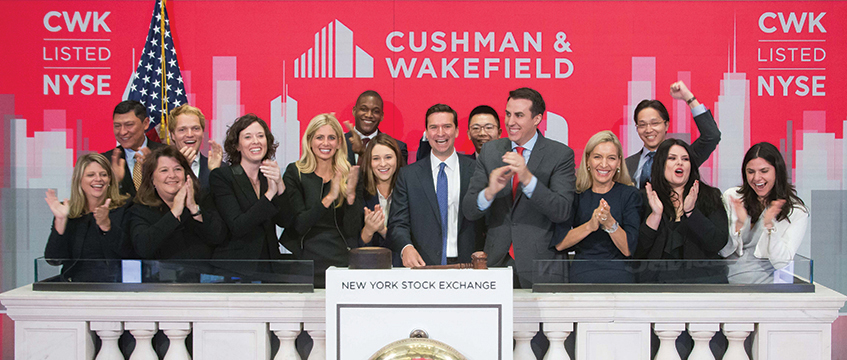Cushman & Wakefield’s $765m (£587m) IPO this week will put it on a footing to keep buying more advisory businesses and ultimately acquire a large global investment management firm if the right opportunity arises.
Having issued guidance to the market of a listing price of $16-$18 the shares opened at $17, with the first trade on the New York Stock Exchange undertaken at $18 – a tacit approval of the stock by the market, following the IPO being almost 3.5-times oversubscribed.
John Forrester, president of Cushman & Wakefield – who steered DTZ through a pre-pack administration, its subsequent ownership by Australian services group UGL, and sale to its private equity owners that then acquired and merged it with Cushman – said that it was an emotional day for him personally.
“Every component part of this company has come together to make it strong. Whether you were part of DTZ, Cushman or Cassidy Turley, we are a single great company now. That’s really what made me very emotional today.
“The bell-ringing [to mark the start of trading of the shares on the New York Stock Exchange] was done by 14 young, brilliant, diverse people. That’s what the company’s about. It’s not about JF or Brett [White, executive chairman and chief executive]. We are opening a new chapter.”
Positive reception
Forrester said that the positive market reception was to do not only with the strengths of the Cushman business, but also dynamics in favour of the sector generally.
“Investors have been telling us for a while that they have been waiting for a Cushman IPO to come out and they like to have more stock in a sector and more choice. We are the most recognisable [real estate] brand in New York, so that generates a lot of interest.
“We also have the highest proportion of recurring income of our peer group and that’s what investors like, rather than a move into more capital markets after being in a market that has had eight years of recovery,” he said.
“The increase in outsourcing is a big driver to our story and to CBRE and JLL too, of course. That is the real fundamental change in industry, that more contracts are going into the hands of fewer suppliers.
“There are also drivers around urbanisation that the market understands, which means ultimately a long-term growth story with more offices and logistics.”
Net proceeds of the float of $719.3m were used to pay down the company’s debt to around $2.6bn. The debt level of the company had been higher under its private ownership than would be expected for a public company, and debt levels will reduce to around 3.1-times EBITDA with an aim to reduce this to around 2.5-times in the near future.
TPG, PAG and Ontario Teachers’ Pension Plan, which listed the business, have retained their ownership for the time being, though their share of Cushman has reduced with the issuance of the new shares.
Strong balance sheet
“We now have a great financial story to increase capacity and a strong balance sheet that means we don’t need to borrow or issue equity to keep buying great businesses like Sherry FitzGerald in Ireland or Inc RE in Australia, and that steady diet of accretive infills will continue out of our normal cash flow,” Forrester added.
One element missing from the Cushman business is a large investment management platform, though it has a UK-focused business in DTZ Investors.
Forrester said that this would require financial resources over and above normal cash flow, but getting his hands on the right business would be difficult.
“If we looked at strategic investment management purchase that would be different. We don’t think cobbling together a group of boutique investment managers globally is the right solution for us.
“If we want to get in to it, it needs to be through the acquisition of a true global platform, but there are very few out there and you don’t know when they will become available. The last big one was ING [REIM, which was sold to CBRE in 2011], so that’s how often they become available.”
To send feedback, e-mail david.hatcher@egi.co.uk or tweet @hatcherdavid or @estatesgazette











